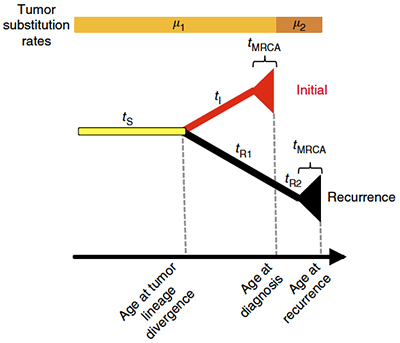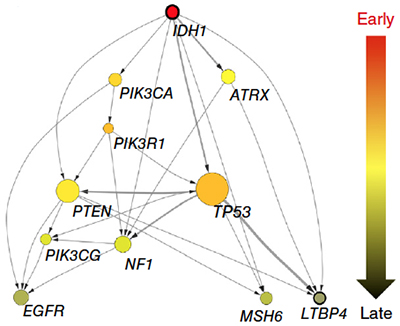News
Study of Glioblastoma Tumor Evolution Reveals Strategies Against Advanced Disease

The researchers' model of tumor evolution indicates that different clonal lineages branch from a common ancestral cell and then diversify, independently causing aggressive tumor behavior at different stages of disease.
Glioblastoma multiforme (GBM) is the most common and most aggressive type of primary brain tumor in adults. Existing treatments against the disease are very limited in their effectiveness, meaning that in most patients tumors recur within a year. Once GBM returns, no beneficial therapeutics currently exist and prognosis is generally very poor.
To better understand how GBM evades treatment, an international team led by Antonio Iavarone and Raul Rabadan at the Columbia University Center for Topology of Cancer Evolution and Heterogeneity has been studying how the cellular composition of GBM tumors changes over the course of therapy. In a paper just published online by Nature Genetics, they provide the first sketch of the main routes of GBM tumor evolution during treatment, showing that different cellular clones within a tumor become dominant within specific tumor states. The study uncovers important general principles of tumor evolution, novel genetic markers of disease progression, and new potential therapeutic targets.
The investigators’ approach is based on a growing appreciation of the importance of clonal heterogeneity within tumors to their response to treatment. This perspective suggests that individual tumor cells undergo a process of Darwinian selection when subjected to therapy. Certain cells are eliminated, but a subset of the ones that survive are resistant and continue to multiply along specific lineages, becoming the ultimate cause of death. Despite this general conceptual understanding, however, scientists have found it very challenging to identify consistent patterns of clonal evolution in solid tumors that would enable them to design specific therapies for specific disease states.
The scientists hypothesized that if tumors evolve along clonal lineages made up of subpopulations of related cells, genomic profiling of cells before treatment and at the time of disease recurrence might enable them to develop the equivalent of family trees of tumor cell ancestry. They performed longitudinal genomic and transcriptomic analyses of tumors from 114 patients with GBM, using this data to reconstruct the evolutionary history of each tumor. Initially, this enabled them to identify mutations, copy number variations, expression profiles, and gene fusions that are differentially associated with specific disease states, including several genetic alterations that had never before been identified.
Using mathematical approaches developed in the Rabadan Lab, the team then used information about changes in the clonal composition of the many individual tumors to build an overarching model of GBM evolution. Surprisingly, the researchers discovered that tumor evolution over the course of treatment is not a linear process. Although one might expect that the cells present after treatment would be descendants of those present before treatment, they instead found that the dominant clones after treatment lack many of the mutations seen in dominant clones before the introduction of therapy. In fact, their model revealed that in most patients the clones responsible for driving different disease states must have diverged from a common ancestral cell many years before the tumor was detected.
This finding suggests that GBM tumors undergo clonal replacement over the course of treatment, with different lineages independently driving an aggressive tumor phenotype at different disease stages. Using techniques the Rabadan Lab developed previously and initially used in a study of leukemias, the investigators constructed what they call a tumor evolutionary directed graph. The model revealed that mutations in IDH1, PIK3CA, and ATRX occur early in GBM; mutations in TP53, NF1, and PTEN occur later; mutations in EGFR are subclonal and occur late, mostly at the time of diagnosis; and mutations in MSH6 and LTBP4 occur specifically during relapse.

Schematic showing the order in which mutations occur in glioblastoma.
Distinguishing alterations that are common to all cells within a tumor versus those that are specific to diagnosis or recurrence could provide valuable information for optimizing targeted therapeutic strategies and clinical trials. For instance, the analysis suggests that EGFRvIII inhibitors, which have been under investigation for treatment of glioblastoma, might not be an ideal choice for targeted therapy because the variant disappears as the tumor evolves. It is more likely that a therapy targeting pre-existing clonal populations that are likely to drive advanced, resistant disease — even if these cell populations are small at the time of diagnosis — could be successful.
“Genetic alterations such as mutations and gene fusions that are present in most cells in untreated glioblastoma tumors and persist after treatment with standard-of-care therapies should provide clinicians with the best possible targets for precision medicine,” Dr. Iavarone explains.
The finding about LTBP4 ’s association with disease recurrence is particularly encouraging, the paper reports, because the corresponding protein is known to regulate the TGF-β pathway, which has previously been shown to be important in aggressive gliomas. In a series of laboratory experiments using glioma cell lines, they showed that silencing LTBP4 markedly reduced cell proliferation. The scientists are currently investigating whether this discovery could offer an effective strategy for eliminating the clones that drive advanced GBM.
In addition, they determined that methylation of the gene MGMT at diagnosis predicted longer survival, while low expression of MGMT at recurrence was significantly related to better prognosis. Most interestingly, the team found relapse-specific gene fusions involving the MGMT gene that drive resistance to treatment. Such a diagnostic marker could in the future potentially serve as a prognostic marker and help clinicians in treatment planning.

Leading the study were Raul Rabadan, PhD, an associate professor in the Departments of Systems Biology and Biomedical Informatics, and Antonio Iavarone, MD, professor of neurology and pathology and cell biology in the Institute for Cancer Genetics, and a member of the Herbert Irving Comprehensive Cancer Center.
“This work illuminates the power of genomic techniques for precision medicine approaches to cancer,” Rabadan says. “Despite the complexity of these tumors, we were able to identify mutations in pathways associated with progression, new fusion genes contributing to drug resistance, and novel markers of survival. We think that this opens some promising avenues for treating aggressive GBM tumors, and for implementing detection techniques that could help in early diagnosis.”
The research was conducted as part of Columbia University’s Center for Topology of Cancer Evolution and Heterogeneity, one of five national centers in the National Cancer Institute’s Physical Sciences–Oncology Network. Other scientists who participated in this study are based at the Fondazione IRCCS Istituto Neurologico Besta (Milan, Italy), Samsung Medical Center (Seoul, South Korea), and the University of Texas at Austin.
— Chris Williams
Related publication
Wang J, Cazzato E, Ladewig E, Frattini V, Rosenbloom DIS, Zairis S, Abate F, Liu Z, Elliott O, Shin Y-J, Lee J-K, Lee I-H, Park W-Y, Eoli M, Blumberg AJ, Lasorella A, Nam D-H, Finocchiaro G, Iavarone A, Rabadan R. Clonal evolution of glioblastoma under therapy. Nat Genet. 2016 Jun 6.